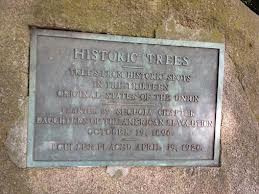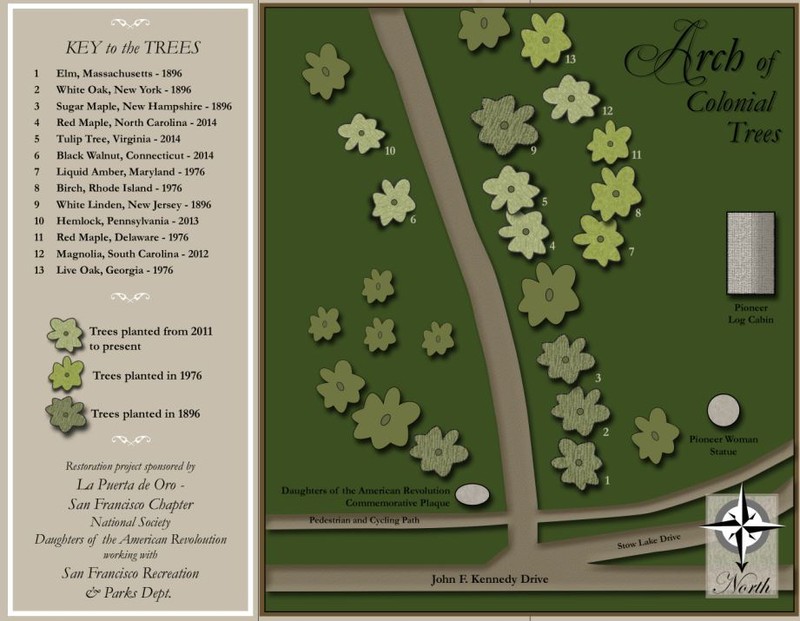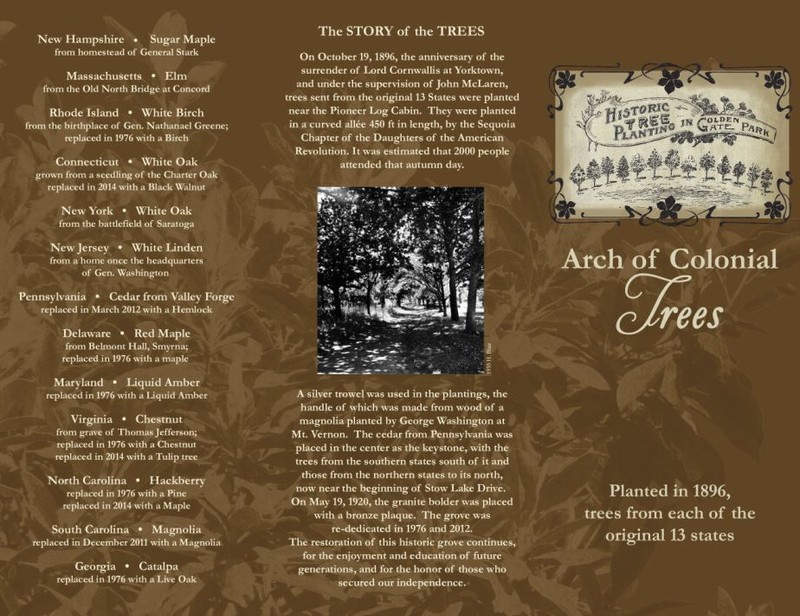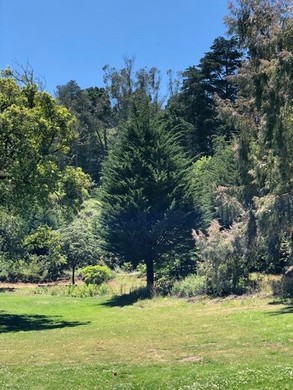Historical Marker, Colonial Trees Grove in Golden Gate Park
Introduction
Author-Uploaded Audio
Listen to a narration of this entry's description by Jenevieve Hughes.
Text-to-speech Audio
Images
Historic Trees Historical Marker in the Colonial Trees Grove, Golden Gate Park

Arch of Historic Trees interpretive signage (Tree Species Identification)

Arch of Historic Trees interpretive signage (The Story of the Trees)

Colonial Trees Grove in Golden Gate Park

Panorama of all 13 Trees in the Colonial Trees Grove

Backstory and Context
Author-Uploaded Audio
Listen to a narration of this entry's description by Jenevieve Hughes.
Text-to-speech Audio
As noted on the Historic Trees Historical Marker, each tree planted within the Colonial Trees Grove in Golden Gate Park is native to one of the original thirteen colonies (now states) in the United States of America. Each tree planted in this grove also holds unique historical significance reflecting a particular event, figure, or symbol from each of the original thirteen colonies.
First planted by the Sequoia Chapter of the Daughters of the American Revolution (DAR) in the autumn of 1896, some of the trees have since been replaced over the years due to the effects of weather and time. The following significant species of trees were included within the Colonial Trees Grove in Golden Gate Park:
- a Sugar Maple from General Stark's homestead (New Hampshire)
- an Elm from the old bridge at North Concord (Massachusetts)
- a Birch from the homestead of General Nathanael Greene (Rhode Island)
- a White Oak from a seedling of the Charter Oak, replaced in 2014 with a Black Walnut (Connecticut)
- a White Oak from the Battlefield of Saratoga (New York);
- a White Linden from a former home of General Washington (New Jersey)
- a Red Maple from Belmont Hall (Delaware)
- a Liquid Amber (Maryland)
- a Chestnut from the grave of Thomas Jefferson (replaced by a Tulip tree in 2014)
- a Hackberry replaced by a Red Maple in 2014 (North Carolina)
- a Magnolia (South Carolina)
- a Catalpa replaced by a living Oak in 1976 (Georgia)
In the center of the Colonial Trees Grove stands a keystone Cedar tree from Valley Forge Pennsylvania. (This tree was replaced by a Hemlock in 2012). The trees from the southern colonies were planted in an arc just south of the Pennsylvania Cedar tree, while the trees from northern colonies were planted in an arc just north of it. The soil that was added to the site during the planting of the Pennsylvania Cedar tree came from the Paris grave of the Marquis de Lafayette, who joined the cause of the American Revolution while gaining the formal support of France and playing a key role in the victory against Britain's Lord Cornwallis at the Battle of Yorktown.
Sponsored by the Sequoia Chapter of the Daughters of the American Revolution (DAR) in October 1896 just after the California Midwinter International Exposition ("World's Fair") earlier that year, it is estimated that some 2,000 people were in attendance to witness and celebrate the planting of the Colonial Trees Grove. While planting the trees, a silver trowel was used, featuring a handle that had been specially crafted from a Magnolia tree which once stood at George Washington's Mount Vernon property. The additional soil that was added to the site during the planting also came from several historic American battlefields that were of particular significance during the Revolutionary War.
The Colonial Trees Grove was further commemorated with a bronze plaque historical marker mounted into a boulder in 1920. The Colonial Trees Grove was re-dedicated in 1976, the year of the U.S. Bicentennial, and again in 2012. Today, this site continues to be maintained for educational purposes as well as for outdoor enjoyment, in honor of earlier generations who fought against Britain in the American War for Independence.
Sources
"Arch of Colonial Trees", San Francisco Recreation & Parks Department. Accessed December 17th 2019. https://sfrecpark.org/parks-open-spaces/golden-gate-park-guide/arch-of-colonial-trees/.
"Arch of Colonial Trees", Atlas Obscura. Accessed December 17th 2019. https://www.atlasobscura.com/places/arch-of-colonial-trees.
"Colonial Trees Grove" , Golden Gate Park. Accessed December 17th 2019. https://goldengatepark.com/colonial-trees-grove.html.
Seewald, Joel. "Historic Trees Historical Marker", The Historical Marker Database. April 13th 2019. Accessed December 17th 2019. https://www.hmdb.org/m.asp?m=132090.
San Francisco Recreation & Park Department
San Francisco Recreation & Park Department
San Francisco Recreation & Park Department
Zkyter at Atlas Obscura
Zkyter at Atlas Obscura
